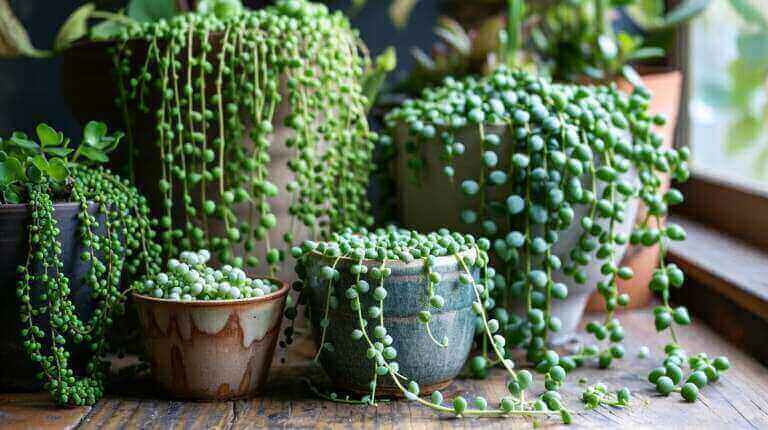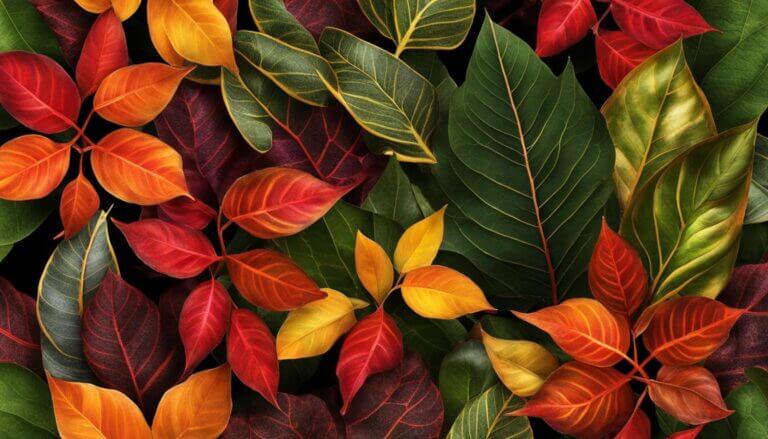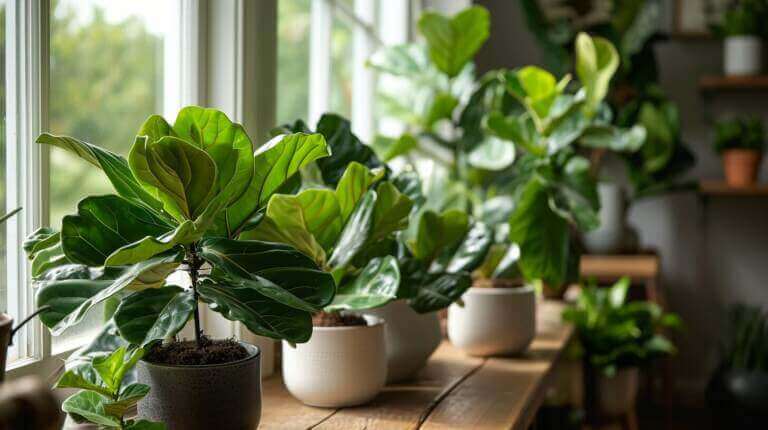Dracaena Marginata vs Dracaena Fragrans: Key Differences Between These Two Popular Dracaena Plant Varieties
When it comes to choosing between popular varieties of different plant, Dracaena Marginata and Dracaena Fragrans for your indoor tropical plants, it’s important to understand the key differences between these two popular dracaena plant varieties.
- Dracaena Marginata, also known as the dragon tree, has thin, grass-like leaves in dark green or burgundy colors.
- Dracaena Fragrans, commonly called the corn plant, has strap-like leaves that can be green, red, or yellow.
- Dracaena Marginata tends to be taller and more upright, reaching heights of 15 feet if left unpruned, while Dracaena Fragrans is usually shorter, growing up to 6 feet as a potted plant.
- Dracaena Marginata is known for its resilience and ability to thrive in low light conditions, making it suitable for indoor environments with less sunlight. Dracaena Fragrans prefers bright, indirect light.
- Dracaena Marginata has a slender and graceful appearance, while Dracaena Fragrans has a fuller and bushier growth habit.
Overall, Dracaena Marginata and Dracaena Fragrans have distinct characteristics in terms of leaf shape, color, and growth habits. These differences should be considered when selecting the right variety of dracaena houseplants for your indoor space. Both species of dracaena are popular houseplants and can thrive with proper care.
Leaf Shape and Color
One of the key distinguishing factors between Dracaena Marginata and Dracaena Fragrans lies in their leaf shape and color variations. Dracaena Marginata, also known as the dragon tree or dragon plant, features thin, grass-like leaves that gracefully fountain off multiple thick stems. These leaves are typically seen in dark green or burgundy hues, adding a touch of elegance to any indoor space.
On the other hand, Dracaena Fragrans, commonly known as corn plant or fragrant dracaena, showcases strap-like leaves that emerge in a beautiful cluster resembling a fountain. These leaves come in a range of vibrant colors, including green, red, and yellow, creating a visually striking display in any room or office.
With their unique leaf shapes and color variations, both Dracaena Marginata and Dracaena Fragrans offer a diverse array of options for plant enthusiasts seeking to add natural beauty addition to any indoor space. Whether you prefer the sleek and slender look of Dracaena Marginata or the lush and colorful appearance of Dracaena Fragrans, these plants are sure to captivate and enhance your home or office environment.
| Dracaena Marginata | Dracaena Fragrans |
|---|---|
| Leaf shape | Thin, grass-like |
| Leaf color | Dark green or burgundy |
| Growth habit | Upright |
| Leaf shape | Strap-like |
| Leaf color | Green, red, or yellow |
| Growth habit | Fuller, bushier |
As you can see, these table showcases the differences in leaf shape, color, and growth habit between Dracaena Marginata and Dracaena Fragrans. Use this information to choose the perfect dracaena plant that fits your personal style and complements your plant for indoor.
Growth Habits
Understanding the growth habits of Dracaena Marginata and Dracaena Fragrans is crucial in determining the ideal size and shape for your indoor space. These two popular dracaena varieties have notable differences in their growth patterns.
Dracaena Marginata, also known as the dragon tree, is typically taller and more upright in its growth habit. If left unpruned, it can reach heights of up to 15 feet. With multiple thick stems, this plant forms a graceful fountain-like shape, with its thin, grass-like leaves cascading downwards.
On the other hand, Dracaena Fragrans, commonly referred to as the corn plant or fragrant dracaena, has a slightly shorter growth habit. As a potted plant, it usually reaches a height of around 6 feet. Its thick, woody stem branches out into a cluster of strap-like leaves that emerge in a fountain-like manner. This gives the plant a fuller and bushier appearance compared to Dracaena Marginata.
| Dracaena Marginata | Dracaena Fragrans |
|---|---|
| Taller and more upright | Shorter and bushier |
| Up to 15 feet if unpruned | Up to 6 feet |
When choosing between Dracaena Marginata and Dracaena Fragrans, consider the available space in your home or office. If you have high ceilings or a larger area to fill, the vertical growth of Dracaena Marginata can create an elegant and eye-catching effect. On the other hand, if you prefer a more compact plant or have limited space, Dracaena Fragrans’ shorter stature may be a better fit.
Light Requirements
Providing the right amount of light is essential for the healthy growth of Dracaena Marginata and Dracaena Fragrans, as their light requirements differ.
Dracaena Marginata is known for its resilience and ability to thrive in low light conditions, making it an ideal choice for indoor environments with less sunlight. This plant can tolerate and even thrive in areas with indirect or low light, making it a popular choice for offices or rooms with limited natural light.
On the other hand, Dracaena Fragrans prefers bright, indirect light. Placing this plant near a window where it can receive filtered sunlight or in a well-lit room will ensure that it thrives. Avoid exposing it to direct sunlight, as this can cause leaf burn and damage to the plant.
By understanding and meeting the light requirements of Dracaena Marginata and Dracaena Fragrans, you can promote healthy growth and ensure that these beautiful houseplants thrive in your indoor space.
Appearance
The appearance of Dracaena Marginata and Dracaena Fragrans varies, adding to their distinct charm as indoor plants.
Dracaena Marginata, also known as the dragon tree, has a slender and graceful growth habit. This plant features thin, grass-like leaves that cascade off multiple thick stems. The leaves of Dracaena Marginata are typically dark green or burgundy in color, creating an elegant contrast against the slender stems. With its sleek and vertical form, this popular indoor plant adds a touch of sophistication to any indoor space.
In contrast, Dracaena Fragrans, commonly called the corn plant or fragrant dracaena, has a fuller and bushier appearance. The strap-like leaves of this species emerge in a fountain-like cluster from a thick, woody stem. Dracaena Fragrans offers a wider range of leaf colors, including green, red, and yellow, which contribute to its vibrant and eye-catching display. The lush foliage of this species gives it a more substantial presence, making it a popular choice for adding volume to indoor gardens.
Whether you prefer the sleek elegance of Dracaena Marginata or the lush fullness of Dracaena Fragrans, both species bring their unique aesthetic appeal to indoor spaces. Their distinct appearances make them excellent choices for enhancing the ambiance and adding a touch of nature to any room.
Indoor Care Tips
Taking proper care of Dracaena Marginata and Dracaena Fragrans is essential for their overall health and well-being as indoor plants. Here are some care requirements and needs to ensure their thriving growth:
Water:
Both Dracaena Marginata and Dracaena Fragrans prefer moderate watering. It is important to keep their soil moist but not overly saturated. Before watering, make sure the top inch of the soil is dry. Overwatering can lead to root rot, while underwatering can cause the leaves to yellow and droop. It is best to water these plants when the soil feels slightly dry to the touch.
Light:
Dracaena Marginata is known for its resilience in low light conditions, making it suitable for indoor environments with less sunlight. However, providing some indirect light will promote healthier growth. On the other hand, Dracaena Fragrans prefers bright, indirect light. Placing it near a window with filtered sunlight or using artificial grow lights can help maintain its vibrant foliage.
Fertilizer:
Both species benefit from regular fertilization during the growing season, which is typically spring and summer. Use a balanced, water-soluble houseplant fertilizer and follow the instructions on the packaging. Avoid over-fertilizing, as it can lead to burned roots and damaged foliage.
Temperature and Humidity:
Dracaena Marginata and Dracaena Fragrans thrive in average room temperatures between 60°F and 75°F (15°C – 24°C). They are adaptable to slightly lower or higher temperatures, but avoid exposing them to extreme cold or heat. These plants also prefer moderate humidity levels. To increase humidity, mist the leaves occasionally or place the pots on a tray filled with water and pebbles.
Pruning and Propagation:
Regular pruning helps maintain the desired shape and size of both Dracaena Marginata and Dracaena Fragrans. Remove any yellow or brown leaves, as well as any damaged or leggy stems. Pruned sections can be propagated by rooting them in water or well-drained soil. Propagation is a great way to expand your collection of these beautiful indoor plants.
By providing the right care, watering, light, fertilizer, and maintaining a suitable environment, you can enjoy the beauty of Dracaena Marginata and Dracaena Fragrans as thriving and eye-catching additions to your indoor space.
| Care Tips | Dracaena Marginata(Madagascar Dragon Tree) | Dracaena Fragrans(Corn Plant) |
|---|---|---|
| Watering | Moderate watering; keep soil slightly dry | Moderate watering; allow top inch of soil to dry |
| Light | Tolerates low light conditions | Bright, indirect light |
| Fertilizer | Regular fertilization during growing season | Regular fertilization during growing season |
| Temperature | 60°F – 75°F (15°C – 24°C) | 60°F – 75°F (15°C – 24°C) |
| Humidity | Moderate humidity | Moderate humidity |
| Pruning | Regular pruning to maintain shape | Regular pruning to maintain shape |
Common Problems and Solutions
While Dracaena Marginata and Dracaena Fragrans are generally easy-to-care-for plants, they can sometimes face common problems that require attention. It’s important to be aware of these issues and take appropriate measures to keep your plants healthy. Here are some common problems you may encounter with these dracaena species:
1. Overwatering
One of the most common problems with Dracaena Marginata and Dracaena Fragrans is overwatering. These plants prefer to dry out between waterings and can suffer from root rot if the soil remains too moist. To avoid overwatering, water the plants thoroughly but allow the soil to dry out completely before watering again. Ensure that the pots have proper drainage to prevent water from accumulating at the bottom.
2. Brown tips or edges on leaves
Brown tips or edges on the leaves can be a sign of low humidity or excess fertilizer. Dracaenas thrive in moderate humidity levels, so if the air in your home is dry, it’s important to increase humidity around the plants. You can do this by placing a tray of water near the plants or using a humidifier. Additionally, avoid overfertilizing the plants as this can cause salt buildup, leading to leaf damage. Follow the recommended fertilizer guidelines and flush the soil occasionally to remove excess salts.
3. Spider mites or mealybugs
Dracaena Marginata and Dracaena Fragrans are susceptible to pest infestations, particularly spider mites and mealybugs. These pests can cause yellowing leaves, webbing, and leaf distortion. To combat infestations, regularly inspect your plants for signs of pests and take immediate action if detected. You can use a mild insecticidal soap or neem oil to control the pests. It’s important to treat all affected areas, including the undersides of leaves and leaf axils, to ensure complete eradication.
4. Leaf drop
Leaf drop can occur due to various factors, including low light levels, temperature fluctuations, or water stress. Ensure that your dracaenas are placed in an area with appropriate lighting, avoiding direct sunlight which can scorch the leaves. Maintain stable temperatures around the plants, avoiding drafts or sudden temperature changes. Lastly, monitor the watering routine, allowing the soil to dry out slightly between waterings but avoiding prolonged periods of drought.
By being aware of and addressing these common problems, you can ensure that your Dracaena Marginata and Dracaena Fragrans remain healthy and thrive in your home. Regularly inspect your plants for any signs of issues and take prompt action to resolve them, providing the necessary care to keep your dracaenas looking their best.
FAQ
What are the key differences between Dracaena Marginata and Dracaena Fragrans?
The key differences between Dracaena Marginata and Dracaena Fragrans include their leaf shape, color, and growth habits. Dracaena Marginata has thinner, grass-like leaves that are typically dark green or burgundy, while Dracaena Fragrans has strap-like leaves that can be green, red, or yellow. Dracaena Marginata is generally taller and more upright, reaching heights of 15 feet if left unpruned, while Dracaena Fragrans is usually shorter, growing up to 6 feet as a potted plant.
What are the light requirements for Dracaena Marginata and Dracaena Fragrans?
Dracaena Marginata is known for its resilience and tolerance of low light conditions, making it suitable for indoor environments with less sunlight. Dracaena Fragrans, on the other hand, prefers bright, indirect light.
How do I take care of Dracaena Marginata and Dracaena Fragrans indoors?
Both Dracaena Marginata and Dracaena Fragrans require regular watering, allowing the soil to dry partially between waterings. They also benefit from occasional misting to increase humidity. It’s important to avoid overwatering, as this can lead to root rot. Additionally, both plants can benefit from occasional pruning to maintain their shape and remove any yellow or damaged leaves.
What are common problems that may arise when caring for Dracaena Marginata and Dracaena Fragrans?
Common problems with Dracaena Marginata and Dracaena Fragrans include overwatering, which can lead to root rot, and low humidity, which can cause dry and brown leaf tips. Spider mites and mealybugs can also be common pests. Regularly inspecting the plants for signs of pests and providing appropriate care can help prevent and resolve these issues.







